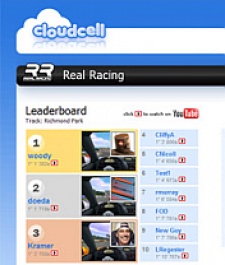Australian developer Firemint scored the mobile hit of this year's Leipzig Games Convention with Real Racing.
The work-in-progress racer was shown running on iPhone and Nokia N95, and had publishers reportedly beating a path to the developer's door to snap up the rights.
We talked to Firemint CEO Robert Murray this week for a catch-up. "We have been working furiously on Real Racing and we are more than happy with the results," he says.
"I really believe that we have the best racing game on any handheld device, and I would hope that some of the unique features will make a splash."
However, Firemint isn't announcing any publishing plans for the game yet, although Murray says the developer will have some "exciting news" soon.
Although Real Racing has some fearsomely impressive 3D visuals, the thing that got Leipzig buzzing was its use of connectivity, with its own community, a spin-off Facebook application, and the ability to upload video replays to YouTube.
Murray says Firemint is keenly focused on making the most of mobile-to-web connectivity, rather than simply seeing sites like Facebook and YouTube as a viral marketing tool.
"The way that we think about it is that the web and the mobile both provide a different sort of window into the same game," he says.
"The web spaces are your social and public window into the game and they are focused on organising information, relationships and long term goals. The mobile is your personal window into the game, and it is focused on short term goals and immediate rewards."
In other words, Firemint thinks that both the mobile and web interface are looking at the same larger game in different ways, with the game itself increasingly stored and controlled in the internet 'cloud'.
"For players this approach brings a more pervasive and socially relevant game, a game that they can care more about if they choose to," he says.
"For developers and publishers, reaching into the web in intelligent ways will increase the exposure of their game and enable better word of mouth marketing."
Murray says Firemint's development philosophy is focused on designing games in an "open, broad and connected" way, to match the capabilities of the latest mobile phones, and indeed the web itself.
Real Racing uses Firemint's in-house Cloudcell platform for its web connectivity, and the platform is set to feature in future games from the company.
"When consumers come to understand what these features mean, they will become baseline and everyone will need to support these things," says Murray.
"I think it is an awesome thing for the player, but potentially very challenging and expensive for publishers and developers. We came to the opinion quite a while ago that this is the future and we might as well get stuck into it rather than wait till it becomes a necessity."
The interesting thing about Real Racing is that Firemint doesn't necessarily need a publishing deal to make it a hit, thanks to the existence of the iPhone App Store and Nokia's N-Gage platform - it could self-publish on either.
Murray says the App Store hasn't really changed Firemint's way of thinking, as it was already working on its own games before Apple launched the store. However, it has provided a route to market.
"It is not just App Store of course," he says. "N-Gage is extremely interesting to us. They have really thought out how to offer an ecosystem that works for everyone and that could ensure the ongoing production of quality titles."
However, he admits that the iPhone has made the whole process of self-publishing much easier for a developer like Firemint. That said, he recognises that there are challenges on the business model side of the equation.
"We have invested a huge amount of money and time into the development of Real Racing, but the question is how do we make that money back if we can only sell a premium game for $10?" he says.
"Nintendo DS has far more units on the market, and premium games sell for US$30 or more. So we are funding a game that is more advanced and costly than a premium Nintendo DS title, but hoping to make the money back at $10 per unit with a fraction of the install base of the Nintendo DS. That is a challenge!"
We await news on how and where Firemint chooses to bring Real Racing to market. Meanwhile, the developer isn't focusing on just one title. It seems 2009 is going to be quite a year for the company.
"We are working towards our plan, to produce high quality, pervasive and social experiences. So you can expect titles with AAA graphics and gameplay, cross-platform interaction, and interesting connections to your broader digital life," he says.
"Next year will be a big one for us. We have been working on some fundamental technology and products for a very long time, so it will be nice to finally make some big announcements."
Interview: Firemint talks iPhone, Web 2.0 and self-publishing
And the buzz around upcoming title Real Racing






















